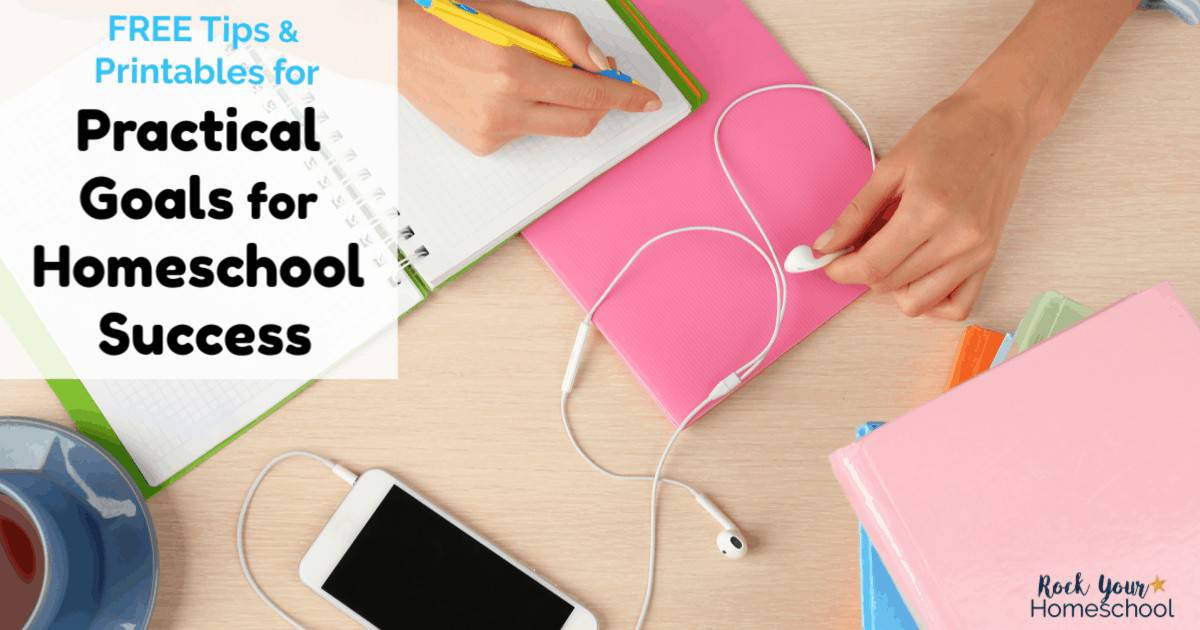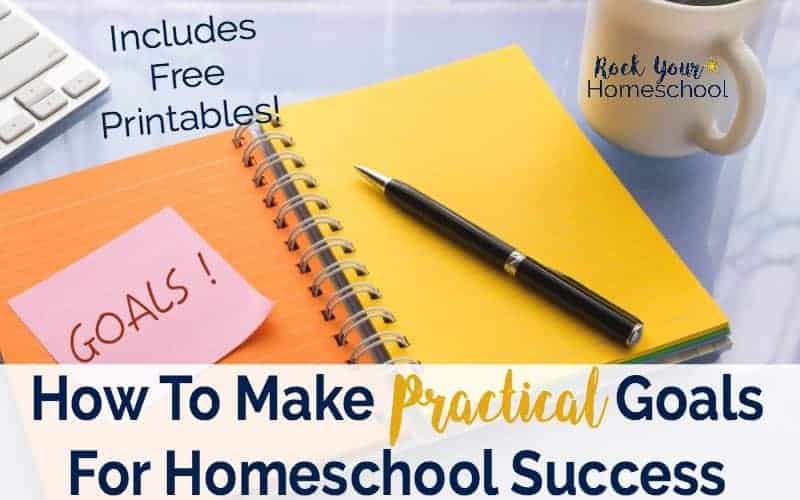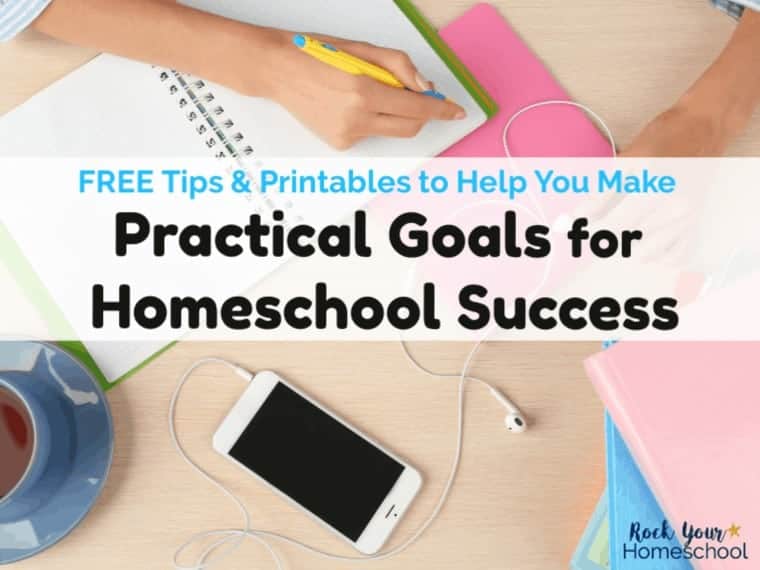How To Make Practical Goals For Homeschool Success
This post may contain affiliate links. Please read my disclosure statement. Thanks for visiting!
Discover how to make practical goals for homeschool success. These free tips and printables will help you get started.
You'll find that practical goal setting is easy and only takes a few minutes a day. With those well-spent minutes, you'll gain a greater focus and sense of achievement because your goals will be based on your homeschool life.

Do you ever feel like you are just spinning your wheels in your homeschool?
Like you are stuck in a hamster wheel and wondering just what it is that you are working so hard to complete and not really getting anywhere?
If you're thinking, "Amy, get out of my head!" then I am so glad that you're here, my friend. This homeschool soccer mom to five boys has lived and breathed all of these thoughts and then some! In fact, I have periods in our homeschool where I continue to struggle.
So, if I continue to have these struggles, why in the world am I writing about practical goals for homeschool success?
Well, I have a tool to use that helps me overcome these struggles. Because, let's face it-struggles are just a part of life 😉 And struggles help us grow-if we let them!
In fact, this tool helps our homeschool life actually get a boost. Sure, we still have our hurdles as the boys get older and homeschooling evolves for our family.
But, these hurdles have become much shorter in size and duration. Like going from a 400-meter high hurdle race to a 100-meter low hurdle dash (finally found a way to incorporate a bit of my high school track experience!)

Why You Need To Make Practical Goals For Your Homeschool
Goals can be a wonderful thing! They help you work towards an end result. Well-set goals can drive you towards self-growth and accomplishment.
Your goals are only going to work, however, if your goals:
- reflect a need in your life
- are realistic
- have measurable steps
- are predetermined
It would be impractical for me to have a homeschool goal of 3 hours of read-aloud followed by a science experiment, history project, and chapter of math. For my homeschool with five boys ages 4-16, it's more practical to have goals of 15-20 minutes group read aloud, the start of a history project, and a math lesson.
When you have practical goals for your homeschool, you are able to focus on what is important.
You prioritize your time as you work to accomplish your pre-established goals.
You're also much less likely to feel like a failure because you're actually getting it DONE!

How To Make Practical Goals For Your Homeschool
Practical goal setting is possible, with a bit of practice.
Initially, you'll need to wade through unrealistic expectations, either self-imposed or acquired from outside sources. You will also need to drop the comparison game and focus on your homeschool.
Your goals can be achieved when you acknowledge and accept your current homeschool status. A homeschool with two kids ages 14 and 16 is going to operate a lot differently than a homeschool with 9 kids ages infant to 15. As much as another homeschool may look perfect, remember the grass always looks greener on the other side 😉
To make practical goals for YOUR homeschool, identify these factors:
- what you have (inventory your supplies and budget)
- who you are (family size and levels)
- when individual family members function best
- specific needs of individual members that must be met (i.e. baby needs fed and changed or diabetic needs blood sugar monitored)
- where you homeschool (what area of your home and size of that space)
- why you homeschool (your purpose and reason for choosing this path)
- how you homeschool (one-on-one, group, computer, or other types of lessons)
- any other factor that is significant to your homeschool (activities, co-op, work, etc.)
Once you have identified these factors specific to your family and homeschool, you'll then work on determining what goals to set.
Do a brain dump of concerns, issues, and problems in your homeschool. You can also list new skills or habits to develop.
Give yourself some time to do your brain dump. Take an honest look at your homeschool, its strengths, and weaknesses. When you have completed your brain dump, step away for at least ten minutes to clear your thoughts.
Before you return to your brain dump list, recall (or establish) your homeschool vision (or mission). Write down your reasons for homeschooling and why it is important for your family. Refer to these reasons often as you work on the practical goal setting process.

Work With Your Practical Goals
With your homeschool vision in mind, prioritize the items in your brain dump.
Identify your number one concern/issue/problem/skill and continue to create a numbered list. Pause and review your list to ensure accurate priorities.
Number one on your list is now your first goal. Take a moment and think about how this goal makes you feel and your thoughts associated with it. Make note of how any of these thoughts or feelings could interfere with your homeschool success.
What size is this goal? Does it seem insurmountable? It's time to break it down into manageable chunks. Filter out the extraneous. Narrow down your chunks.
As an example, let's say your number one goal is to establish a morning time routine. (For a great resource, you must check out Pam Barnhill's Your Morning Basket podcast and resources.) After learning more from Pam's wisdom, you decide on the specific subjects and concepts that you want to realistically cover during this learning time. You feel a bit overwhelmed with all that you want to include.
Take a deep breath.
Determine the most important part of morning time that you want your kids to learn. Look at your family's sleep and wake schedule. What approximate time of day would you like to start morning time? Where will you do it? What supplies do you need? How long would you realistically like to aim for each morning time session? What will you do if you meet resistance or behavior issues?
Continue to ask yourself these types of questions prior to working on your goal. You don't want to spend too much time on this step but it will help you at least prepare for a few possible snags towards achieving your goal.
Based on your considerations, write down your goal in specific terms. For the above example, it might look something like: "Our homeschool will begin each day around 9:00 am with morning time. We will say the pledge, a prayer, sing a hymn, work on a memory verse, and do a read-aloud. Our morning time will take place at our dining room table for about thirty minutes. Any child that is resistant to participating will need to sit in time out for __ minutes."
This goal is rather large. Break it down further into three chunks like 1) start around 9:00 am, 2) participation in pledge and prayer, and 3) memory verse. You can build upon these chunks to reach your original goal.
And ask yourself: What strategies do you need to use in order to accomplish all three steps of this goal?
As you work on your goal setting for your homeschool, you may notice other areas that need attention. And that's okay!
Add those areas (like a healthy morning routine) to your brain dump. If necessary, reprioritize so you are working on what will benefit your homeschool the most at this time.
Free Printable Practical Goals For Your Homeschool
To help with practical goal setting, I created these three free printable worksheets. Top 3 For Me! comes in daily, weekly, and monthly versions.
The purpose of these worksheets is to break down your current goal into bite-size chunks, as well as establish realistic strategies to help you achieve it.
Here is a video from a Facebook Live to help explain it better:
To get your FREE printable Top 3 For Me! worksheets for practical goal setting, subscribe to Rock Your Homeschool. You'll receive weekly updates plus access to exclusive subscriber freebies (like Journal to Find Your Homeschool Groove!).
Click here or on the image below to subscribe and get your FREE Top 3 For Me! worksheets!
Remember, you can do this! Practical goals will help you find greater satisfaction in your homeschool and better connection with your kids. Instead of worrying if you are doing enough, you will be finding your homeschool groove!


I am doing this home school thing for the first time. Can you give me any tips on how you prep yourself for the lessons that you will be helping your child learn?
Hey-so very sorry that I'm just seeing this! I often prep a bit the night before. To be honest, I don't do a lot of prep. I try to get familiar with the curriculum or resource before we use. Then, I often just shoot from the hip. Some curricula have teacher guides that I loosely use. I don't stress about it very much 😉